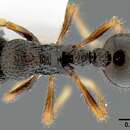en
names in breadcrumbs


Taxonomic history
Combination in Lordomyrma: Kugler, 1994 PDF: 26.See also: Sarnat, 2006 PDF: 23.(Figs. 10, 11)
Rogeria rugosa Mann , 1921: 455.
Description. Worker. TL 3.36-3.77, HL 0.77-0.85, HW 0.71-0.76, CI 0.86-0.94, SI 0.68-0.72, REL 0.19-0.22, PSLI 1.28-1.48, MFLI 0.92-1.00, DPWI 0.98-1.10 (10 measured).
A medium-sized dark brown species with a rugose face and mesosoma, long upturned propodeal spines, small eyes and striated procoxae. In full face view, posterior margin of head evenly convex with rounded corners. Clypeus without strong carinae. Frontal carinae strongly produced, extending beyond posterior level of eye before integrating into dorsolateral rugoreticulum. Antennal scrobe lightly impressed, filled with dense arcuate rugoreticulum. Eyes relatively small. In profile promesonotum modestly sized, convex. Propodeal spines strong, slightly upturned distally and divergent; in profile when measuring from propodeal spiracle one and one third to one and one half times as long as width of procoxa. Propodeal lobes strong, long and upturned. Petiole robustly built; in lateral view anterior face of node weakly concave and gently sloped, posterior face convex and gently sloped, apex occurring at anterior angle of node. Postpetiole with anterior and dorsal faces evenly convex, apex occurring anterior to midline. Mandibles striate with sparse, setigerous foveolae. Middorsum of head overlain by a thick, widely spaced rugoreticulum. In oblique lateral view, face packed with dense rugoreticulum. Frontal lobes with one pair of carinae in addition to the frontal carinae. Promesonotum packed with dense rugoreticulum. In dorsal view, propodeum smooth and shining with a distinct transverse carina proximal to the metanotal groove; declivitous face with transverse carinae between propodeal spines. Procoxae transversely striate. Sides of mesonotum, metapleuron and propodeum overlain by coarse, widely spaced and intersecting rugae. Petiole and postpetiole coarsely rugoreticulate. Gaster smooth and shining. All dorsal surfaces with a suberect to erect acuminate yellowish hairs, the longest of which are longer than the length of the eye. Head, mesosoma and gaster dark reddish brown, appendages lighter.
Type Material. Syntypes, 1 dealate queen, workers, Nadarivatu, [Viti Levu] Fiji (W.M. Mann) (MCZC, NMNH) (examined).
Other Material Examined. FIJI: Viti Levu: Monasavu Rd., 1.75 km SE Waimoque Settlement, 17°40'13"S 177°59'38"E, 850 m, 28.viii.2006 (E.M. Sarnat #2367); Mt. Tomaniivi, 2.4 km E Navai Village, 17°37'06"S 178°00'30"E, 930 m, 1.ii.2005, secondary/primary forest ground foraging (E.M. Sarnat #1771, #1773, #1793); Mt. Tomaniivi, 2.4 km E Navai Village, 17°37'05"S 178°00'33"E, 930 m, 1.ii.2005, mid-elevation rainforest, nesting in soil (E.M. Sarnat #2147).
Discussion. Lordomyrma rugosa is one of the most distinctive species of Lordomyrma in Fiji. Like L. levifrons,L. polita and L. curvata , this species possesses long propodeal spines, well developed, upturned propodeal lobes, and a robust petiole. It differs from the general appearance of the aforementioned species in its small eyes, darker coloration, and the heavy rugoreticulum covering all surfaces of its face. The only other Fijian congener with such strong facial sculpturing is L. striatella , from which L. rugosa can be distinguished by its larger size, coarser sculpture, rugoreticulate antennal scrobes, longer propodeal spines and lobes, and more robust petiole. Additionally, L. rugosa is the only known species of all Fijian Lordomyrma to bear strong striations on its mandibles and procoxae.
Distribution and Biology. Lordomyrma rugosa is known only from the Nadarivatu, Mt. Tomaniivi area. Mann (1921) notes that the colonies are small and live beneath stones or in the ground, and that the workers are slow moving. I collected 66 workers and four males from a nest that was excavated in a clay soil with a 1mm entrance in the bare soil, and additional workers were observed on stones in another locality.